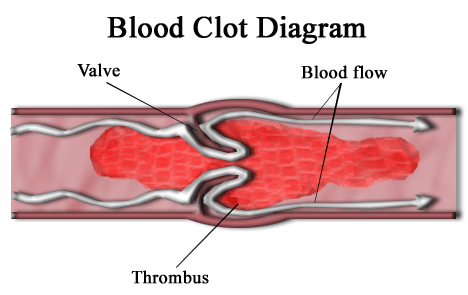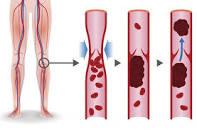
Recently Diagnosed or Relapsed? Stop Looking For a Miracle Cure, and Use Evidence-Based Therapies To Enhance Your Treatment and Prolong Your Remission
Multiple Myeloma an incurable disease, but I have spent the last 25 years in remission using a blend of conventional oncology and evidence-based nutrition, supplementation, and lifestyle therapies from peer-reviewed studies that your oncologist probably hasn't told you about.
Click the orange button to the right to learn more about what you can start doing today.
- You are here:
- Home »
- Blog »
- Multiple Myeloma »
- Multiple Myeloma Side Effect- Blood Clot Relapse- Anticoagulation?
Multiple Myeloma Side Effect- Blood Clot Relapse- Anticoagulation?

“…the data on VTE recurrence with or without continued anticoagulation are limited, and it is impossible to advise whether a (MM) patient’s risk for VTE exceeds the bleeding risk of ongoing anticoagulation.”
Blood clots are a serious multiple myeloma side effect of chemotherapy. According to the article linked below, multiple myeloma (MM) patients should/should not be given preventative (venous thromboembolism-VTE/DVT) anticoagulation beyond six months. In other words, oncology doesn’t know what to advise MM patients and survivors on the issue of prophylactic anticoagulation.
What is known is that MM patients are at a high risk of developing blood clots. More importantly, blood clots increase a MM patient’s risk of death.
I consider my own VTE/DVT experience as a myeloma patient and survivor to be somewhat prototypical.
I was diagnosed with multiple myeloma in 2/94. I developed a VTE in my left leg several weeks after I began my induction therapy in March of 1995. I then spent 4 days in the hospital undergoing intravenous heparin. The clot seemed to resolve and my oncologist put me on Warfarin (Coumadin). I continued coumadin therapy for the remainder of my active MM therapy.
Several years later, I developed another VTE in the other leg. I re-started coumadin therapy.
It was this time period (late 1990’s) that I was questioning all things conventional when it came to my MM treatment and survival. I had already lived through several short-term side effects of my conventional therapies and I was developing several other late-stage side effects such as the VTE, cataracts and radiation-induced lumbo-sacral plexopathy (nerve damage).
Several years of aggressive MM therapies did little to control my MM and I had become jaded with conventional oncology.
Because conventional oncology had done little to manage my two blood clots and because coumadin was known to cause a variety of short and long-term side effects, I researched possible non-toxic substitutes.
I took myself off coumadin and began a series of evidence-based, non-toxic VTE therapies including frequent exercise, enzymes, nattokinase, omega-3 fatty acids- all in an effort to both resolve my existing VTE as well as prevent another VTE from occurring.
In other words, I believe that I have prevented further blood clots, a serious MM side effect, with evidence-based but non-toxic therapies.
Therefore my experience relative to the article linked below is that MM patients should consider evidence-based conventional prophylactic anticoagulation therapy for their shortterm needs but those conventional therapies should not be continued beyond six months.
Evidence-based but non-toxic anticoaqulant therapy should be continued beyond six months. I intend to continue my non-toxic anticoagulant therapy for the rest of my life.
Do you have MM? Do you have a VTE? Scroll down the page, post a question or comment and I will reply to you ASAP.
David Emerson
- MM Survivor
- MM Cancer Coach
- Director PeopleBeatingCancer
Recommended Reading:
ASCT for Multiple Myeloma-Not So “Evidence-based”?
Should anticoagulation for cancer-associated thrombosis extend beyond 6 months?
“Yes.
However, this depends on a case-by-case basis, and it also could depend on the type of anticoagulant used.
However, in order for physicians to decide if they should extend prophylaxis beyond 6 months, the risk for VTE recurrence needs to be higher than the potential risk of the intervention.
Patients are at increased risk for bleeding if they continue anticoagulation. VTE among patients with cancer is associated with high morbidity, which is why we want to continue some form of anticoagulation to prevent VTE recurrence. The majority of VTE cases occur among patients with advanced cancer and metastatic disease; thus, these patients certainly will need to continue anticoagulation beyond 6 months to prevent recurrent VTE
Patients are at increased risk for bleeding if they continue anticoagulation. VTE among patients with cancer is associated with high morbidity, which is why we want to continue some form of anticoagulation to prevent VTE recurrence. The majority of VTE cases occur among patients with advanced cancer and metastatic disease; thus, these patients certainly will need to continue anticoagulation beyond 6 months to prevent recurrent VTE…
No.
Although the treatment of cancer-associated thrombosis in the first 6 months is based on meta-analysis of several randomized controlled trials, the data beyond this time point are considerably lacking.
However, the data on VTE recurrence with or without continued anticoagulation are limited, and it is impossible to advise whether a patient’s risk for VTE exceeds the bleeding risk of ongoing anticoagulation. Further, there are even less data supporting any particular anticoagulant of choice.


